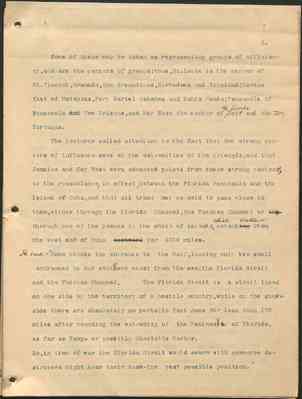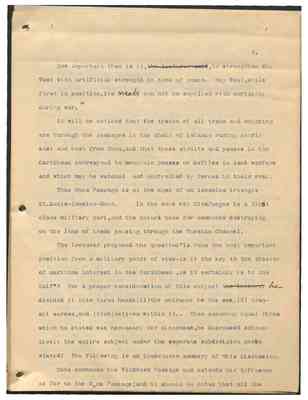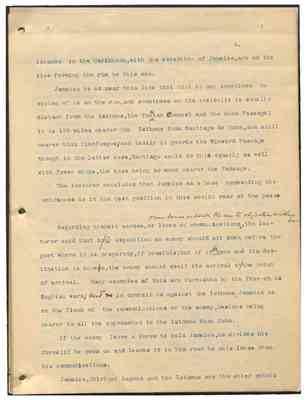Pages
Mahan A. T. 1896
19 CONFIDENTIAL
[stamp: Section 1 Envelop 3] Year 1896 No. 21.
Author: Mahan, Capt ^A. T.^ USN. Contents: Abstracts of his Lectures 1896. (1. Strategy of Caribbean (2. Napoleon's Campaign of 1796.)
[stamp LIBRARY] ARCHIVES OF NAVAL WAR COLLEGE U. S. NAVAL STATION, NEWPORT, R. I.
DECLASSIFIED LAW DOD MEMO OF 3 MAY 1972, SUBJ: DECLASSIFICATION OF WWII RECORDS
To be returned
[margin: Strategy]
[Abstract Capt Mahan's lectures, 1896]
1.
Captain Mahan delivered a course of lectures upon Strategy, clearly and forcibly setting forth the great truths of the Art of War. The course this year comprised those ^lectures^ of the year before, though rewritten and with many changes and additions. The whole course was divided into two series; the subject of the first of these series being "The Strategic Features of the Caribbean".
In this the lecturer pointed out that the whole theater of interest in the Caribbean may be included in a symmetrical figure, an isoceles triangle with the corners lopped off. The base of this triangle is a line joining Pensacola and St. Thomas, 1600 miles long. Lines join Pensacola with the Passes of the Mississippi and St. Thomas and St. Lucia; these lines form the lopped off corners.
These corners are then joined to the apex at Panama forming there an angle a little larger than a right angle.
The line from the Passes to Panama is 1300 ^miles^, and the line from St. Lucia to Panama is a little less than, or 1200 miles long.
This triangle includes, or very nearly includes all the chief points of interest in this locality; that is, the Mississippi, Key West, Havana, Cienfuegos, Santiago de Cuba, Samana Bay, St. Thomas Kingston, Chiriqui, Lagoon, Colon, Gaudaloupe and St. Lucia; and it will be noticed, in passing that the first class powers, as the United States and Great Britain, are separated by a chain of points belonging to the inferior or third class powers.
2.
Some of these may be taken as representing groups of efficiency, and are the centers of groups; thus, St. Lucia is the center of St. Vincent, Granada, the Grenadines, Barbadoes and Trinidad; Havana that of Matanzas, Port Mariel Cabanas and Bahia Honda; Pensacola of Pensacola and New Orleans, and Key West the center of ^the Florida^ Keys and the ^Dry^ Tortugas.
The lecturer called attention to the fact that the strong centers of influence were at the extremities of the triangle, and that Jamaica and Key West were advanced points from these strong centers; to the resemblance, in effect, between the Florida Peninsula and the Island of Cuba, and that all trade may be said to pass close to them, either through the Florida Channel, the Yucatan Channel or thg through one of the passes in the chain of islands, ^which^ extending Eastward from the west end of Cuba eastward for 1000 miles.
^He said. - "^ Cuba blocks the entrance to the Gulf, leaving only two small entrances to our southern coast from the sea; the Florida Strait and the Yucatan Channel. The Florida Strait is a strait lined on one side by the territory of a hostile country, while on the shore side there are absolutely no ports; in fact none for less than 170 miles after rounding the extremity of the Peninsula of Florida, as far as Tampa or possibly Charlotte Harbor.
So, in time of war the Florida Strait would swarm with commerce destroyers right near their base - the best possible position."
3.
How important then is it, the lecturer said, to strengthen Key West with artificial strength in time of peace. Key West, while first in position, its needs can not be supplied with certainty during war."
It will be noticed that the tracks of all trade and shipping are through the passages in the chain of islands runing nearly east and west from Cuba, and that these straits and passes in the Caribbean correspond to mountain passes or defiles in land warfare and which may be watched and controlled by forces in their rear.
Thus Mona Passage is at the apex of an isosoles triangle St. Lucia-Jamaica-Mona. In the same way Cienfuegos is a first class military port, and the natural base for commerce destroying on the line of trade passing through the Yucatan Channel.
The lecturer proposed the question "Is Cuba the most important position from a military point of view - is it the key to the theater of maritime interest in the Caribbean, as it certainly is to the Gulf"? For a proper consideration of this subject the lecturer ^he^ divided it into three heads; (1) the entrance to the sea, (2) transit across, and (3) objectives within it.. Then assuming equal force which he stated was necessary for clearness, he discussed exhaustively the entire subject under the separate subdivision above stated: The following is an inadequate summary of this discussion.
Cuba commands the Windward Passage and extends her influence as far as the Mona Passage; and it should be noted that all the
4.
islands in the Caribbean, with the exception of Jamaica, are on the line forming the rim to this sea.
Jamaica is so near this line that that it may sometimes be spoken of as on the rim, and sometimes on the inside; it is equally distant from the Isthmus, the Yucatan Channel and the Mona Passage; it is 150 miles nearer the Isthmus than Santiago de Cuba, and still nearer than Cienfuegos; and lastly it guards the Winward Passage though in the latter case, Santiago could do this equally as well with fewer ships, the base being so much nearer the Passage.
The lecturer concludes that Jamaica as a base commanding the entrances is in the best position in this sea; in rear of the pass
Regarding transit across, or lines of communications, from bases outside the sea to objections within is the lecturer said that in a^n^y expedition an enemy should sit down before the port where it is preparing, if possible; but if it ^be^ gone and its destination is knowen, the enemy should await its arrival at the point of arrival. Many examples of this are furnished by the French and English wars; ^and^ so in operations against the Isthmus, Jamaica is on the flank of the communications of the enemy, besides being nearer to all the approaches to the Isthmus than Cuba.
If the enemy leave a force to hold Jamaica, he divides his force; if he goes on and leaves it in his rear he cuts loose from his communications.
Jamaica, Chiriqui Lagoon and the Isthmus are the chief points




